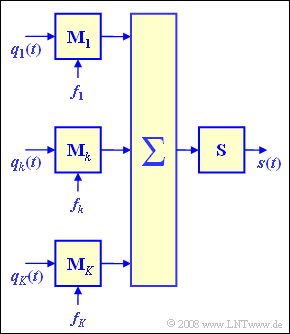Difference between revisions of "Aufgaben:Exercise 1.1Z: VHF II Broadcasting"
m |
m |
||
| Line 34: | Line 34: | ||
{Which multiplexing method is used here? | {Which multiplexing method is used here? | ||
|type="()"} | |type="()"} | ||
| − | + Frequency | + | + Frequency Division multiplexing. |
| − | - Time | + | - Time Division multiplexing. |
{What is the maximum number of programs that could be transmitted in the VHF II band? | {What is the maximum number of programs that could be transmitted in the VHF II band? | ||
| Line 46: | Line 46: | ||
- The range of FM radio waves is greater than that of long-wave, medium-wave and short-wave broadcasting. | - The range of FM radio waves is greater than that of long-wave, medium-wave and short-wave broadcasting. | ||
- The signal arriving at the receiver $r(t)$ is almost indistinguishable from the transmission signal $s(t)$. | - The signal arriving at the receiver $r(t)$ is almost indistinguishable from the transmission signal $s(t)$. | ||
| − | + | + | + The functional unit of a radio receiver for channel separation ("setting the radio station") is the tuner. |
<br><br> | <br><br> | ||
| Line 52: | Line 52: | ||
</quiz> | </quiz> | ||
| − | === | + | ===Model solution=== |
{{ML-Kopf}} | {{ML-Kopf}} | ||
| − | '''(1)''' | + | '''(1)''' <u>Answer 1</u> is correct. |
| − | * | + | *'''FDM''' (''Frequency Division Multiplexing''). |
| − | * | + | *The alternative multiplexing method, '''TDM''' (''Time Division Multiplexing'') can only be implemented with a digital communications system. |
| − | '''(2)''' | + | '''(2)''' From the total bandwidth $\text{20.5 MHz}$ and the channel bandwidth $\text{0.3 MHz}$ we get $\underline{K = 68}$. |
| − | '''(3)''' | + | '''(3)''' <u>Answers1 und 4</u> are correct: |
| − | * | + | *The channel spacing and thus the bandwidth 300 kHz $\text{300 kHz}$ available for a channel is significantly larger in the VHF range than for long, medium and short wave broadcasting. Although the frequency modulation used in FM broadcasting is characterized by better quality, it also requires more bandwidth. |
| − | * | + | *For comparison, in the medium wave range, amplitude modulation and a channel spacing of $\text{9 kHz}$ is always used (in Europe). The AF bandwidth is $\text{4.5 kHz}$. |
*Die Reichweite ist bei UKW geringer als in den anderen Frequenzbereichen, da UKW–Radiowellen nicht an der Ionosphäre reflektiert werden. Daher besteht ein UKW–Sendernetz meist aus recht vielen Sendern, die in geringen Abständen – meist auf Anhöhen – aufgebaut sind ⇒ Antwort 2 ist falsch. | *Die Reichweite ist bei UKW geringer als in den anderen Frequenzbereichen, da UKW–Radiowellen nicht an der Ionosphäre reflektiert werden. Daher besteht ein UKW–Sendernetz meist aus recht vielen Sendern, die in geringen Abständen – meist auf Anhöhen – aufgebaut sind ⇒ Antwort 2 ist falsch. | ||
*Das am Empfänger ankommende Signal hat auf Grund der Freiraumdämpfung, die zumindest quadratisch mit der Entfernung zunimmt, einen sehr viel kleineren Pegel als das Sendesignal $s(t)$ ⇒ Antwort 3 ist falsch. | *Das am Empfänger ankommende Signal hat auf Grund der Freiraumdämpfung, die zumindest quadratisch mit der Entfernung zunimmt, einen sehr viel kleineren Pegel als das Sendesignal $s(t)$ ⇒ Antwort 3 ist falsch. | ||
Revision as of 15:13, 28 October 2021
Electromagnetic waves in a frequency range from $\rm 30$ to $\text{300 MHz}$ – corresponding to wavelengths between one and ten metres – are referred to as ultra-short wave (USW).
In common parlance, USW is also understood to mean the VHF II (Very High Frequency) band, from $\text{87.5}$ to $\text{108 MHz}$ , which is still primarily used in Central Europe today for transmitting frequency-modulated radio programs using analog technology.
The entire frequency band is divided into several channels, each with a channel spacing of $\text{300 kHz}$.
The diagram displays the principle as a flow chart:
- A total of $K$ signals $q_k(t)$ with different carrier frequencies $f_1$, $f_2$, ... , $f_K$ are modulated and added together.
- The summed signal is then beamed from a transmitter after power amplification.
- This outgoing signal is referred to as the transmission signal $s(t)$.
Hints:
- This exercise belongs to the chapter Objectives of modulation and demodulation.
- Particular reference is made to Channel bundling – frequency division multiplexing.
Questions
Model solution
- FDM (Frequency Division Multiplexing).
- The alternative multiplexing method, TDM (Time Division Multiplexing) can only be implemented with a digital communications system.
(2) From the total bandwidth $\text{20.5 MHz}$ and the channel bandwidth $\text{0.3 MHz}$ we get $\underline{K = 68}$.
(3) Answers1 und 4 are correct:
- The channel spacing and thus the bandwidth 300 kHz $\text{300 kHz}$ available for a channel is significantly larger in the VHF range than for long, medium and short wave broadcasting. Although the frequency modulation used in FM broadcasting is characterized by better quality, it also requires more bandwidth.
- For comparison, in the medium wave range, amplitude modulation and a channel spacing of $\text{9 kHz}$ is always used (in Europe). The AF bandwidth is $\text{4.5 kHz}$.
- Die Reichweite ist bei UKW geringer als in den anderen Frequenzbereichen, da UKW–Radiowellen nicht an der Ionosphäre reflektiert werden. Daher besteht ein UKW–Sendernetz meist aus recht vielen Sendern, die in geringen Abständen – meist auf Anhöhen – aufgebaut sind ⇒ Antwort 2 ist falsch.
- Das am Empfänger ankommende Signal hat auf Grund der Freiraumdämpfung, die zumindest quadratisch mit der Entfernung zunimmt, einen sehr viel kleineren Pegel als das Sendesignal $s(t)$ ⇒ Antwort 3 ist falsch.
- Im Rundfunkempfänger hat tatsächlich der Tuner die Aufgabe der Kanalseparierung ⇒ Antwort 4 ist richtig.
